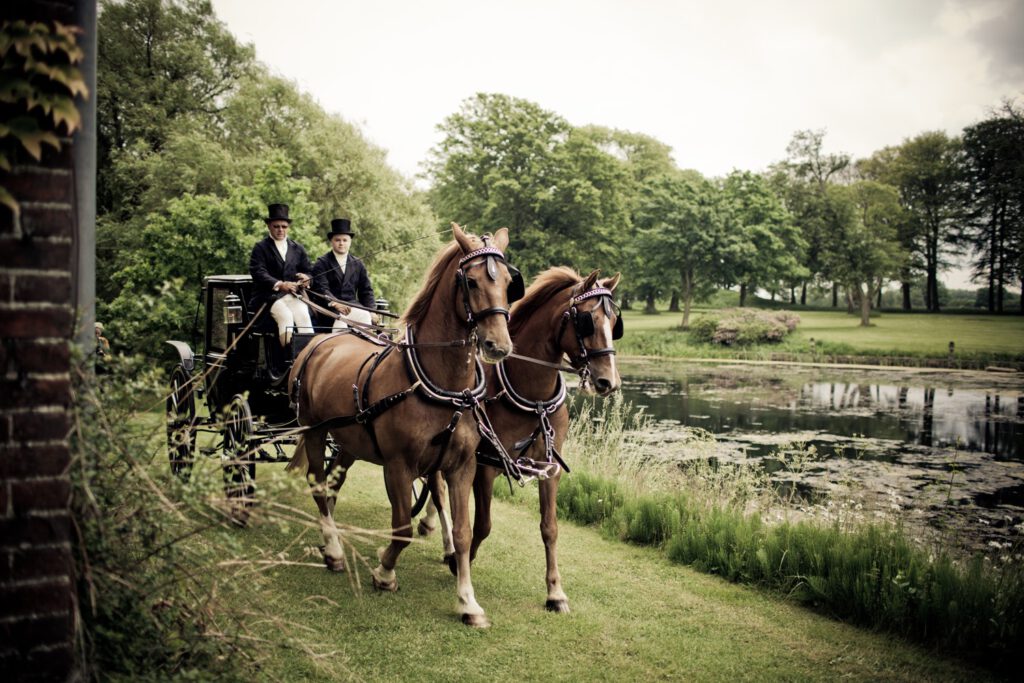Animal traction was the main means of transporting people and loads until the arrival of the railroad. It has been practiced daily for centuries using specific vehicles of all kinds for pleasure as well as for work, in times of peace as well as in times of war. This has left deep traces in the collective memory and has been materialized in countless works of art. But it is only in the XXth century that the practice of driving and its competitions will be registered among the equestrian disciplines.

Driving in History
Let’s go over some historical stages before arriving at the modern world: the Sumerians would be the first to have used the wheel. The Pharaohs hunted lions in their chariots. Quadriga races were included in the Greek Olympic games. In the 15th century, a cartwright in the small Hungarian town of Kokske invented the turning front end, which allowed carriages to turn shorter; hence the origin of the word “coach driver”. King Henry IV of France used primitive carriages for his travels; he was assassinated in one of them.
The invention of the collar, as important as that of the stirrup for horseback riding, finally made it possible to pull heavier loads and to plow. In the 18th century, urban and inter-city public transport appeared. The apogee in terms of harnesses and luxury carriages was reached at the end of the 19th century. In 1972, Prince Philip of Edinburgh codified driving competitions. But our purpose is not to retrace the history of horse-drawn vehicles…
Today, driving has become an equestrian sport so well developed by the “drivers” (we say “drivers” for women) – in European countries as well as in the United States – that it gives rise each year to a World Championship. The first of its kind, for four-horse teams, was held in Munster in 1972. This “4 horse championship” alternates every other year with a “2 horse championship” for pairs. There is also a “Championship with 1”, which appears like the others in the calendar of the International Equestrian Federation.
Driving: The events of the official international cycle.
Subject to the F.E.I. international rules, a Championship, or an International Driving Competition (C.A.I.) includes three distinct events:
Dressage
This is a recovery with compulsory figures. It is performed on a 100 m x 40 m arena. Several official protocols have been established, graduated according to their difficulty from 1 to 7. Each recovery lasts about ten minutes. The ground dedicated to the driving must be firm. Grass is suitable, while soft sand is not. The letters for the mounted dressage are the same as those for the arena. The dressage dressage consists of only two gaits: walk and trot. They are scored by a panel of three judges for the minor competitions and five for the more advanced ones.
Marathon
It is a course of about twenty kilometers including:
– A road race at free pace observing a pre-established hourly average of 14 to 15 km/h;
– Two phases of 1 km each, to be run at walking pace, respecting an average speed of 7 km/h;
– A short phase (3 to 4 km) of fast trotting at 17 to 19 km/h, galloping is prohibited;
– A phase of 13 to 14 km/h comprising 8 obstacles, each of which is individually timed. These obstacles are coded and consist of half a dozen “gates” to be crossed in order and indicated by the letters of the alphabet.
There are penalties for exceeding the time limit. The seconds of crossing the obstacles are added up and transformed into penalty points: it is thus a question of passing them as quickly as possible. Galloping is tolerated.
Handling
This is a course in the arena composed of 20 gates to be passed in order at a speed of 210 to 230 m/min (canter allowed). Any time exceeded is penalized. The gates are marked with pins topped with balls. The distance between these pins depends on the type of event. Each ball knocked down represents 5 penalty points.
The various categories of carriages give rise to separate classifications during the competitions. They are divided into one-horse or one-pony (single), two-horse or two-pony (pair or tandem) and four-horse or four-pony.
The total number of penalty points incurred constitutes the ranking, the winner being the one with the lowest total number of points. It should be noted that the order of these events is based on that of a mounted event. In the events contested by ponies, the imposed averages are lower. For the moment, there is no World Championship for ponies, but only a European Cup.
Driving: Horses, carriages, and harnesses
All breeds of horses are allowed to compete. Among the main ones we can note the Lippizans, the Trakheners, the Hanoverians, the Dutch and Swedish Thoroughbreds, the Franches-Montagnes, the Cobs, the Orlovs, the Morgans. For ponies, Welsh, Haflingers and Fjords. A team can be composed of a mix of these origins or crosses from these breeds or others. For multiple carriages, uniformity of coat and a good match of horse size are important criteria. The action of the horses must be the same.
From the carriage horse trade, it can be said that the costs are lower compared to other equestrian disciplines. But you need several horses to practice this sport! The value of the crews also very often depends on their degree of preparation, knowing that it takes several years of training to reach an international level.
Two categories of four-wheeled carriages are used: one, very neat, called “presentation”, is used for dressage and handling; the other, more rustic, is used for the marathon. In both cases, they are equipped with a metal frame and their brakes are disc brakes. Manufacturers are constantly improving marathon cars in terms of wheel diameter and inclination, and in terms of the tiller, which is often connected to the car by a joint. On a show car, the driver must wear a headdress, gloves and an apron and the car must be equipped with lanterns.
Beautiful leather harnesses are used for dressage and handling, while nylon-reinforced webbing harnesses are often sufficient for marathon driving. Two traction techniques are used: the collar or the breast strap. The latter is predominant because of its ease of adaptation to all types of morphology.
The driver communicates his orders to the horses by voice, by means of long guides, whose precise use requires a long training, and thanks to the touches of the wick of his whip. These “aids” must remain discreet.
Driving: traditional competitions
The purpose of the traditional competitions is to gather crews copied on those of the past. The carriage used must be old or an exact copy of a model that was used in the 19th century. The harness and the dress of the driver and his passengers must be of the same style. They are organized under the aegis of the French Driving Association (A.F.A.). The tests are measured out to avoid damage to the vintage cars. They include an important “presentation” test, during which the qualities of the elements of the crew are carefully gauged: horses and harnesses, carriages, and passengers’ clothing. The sets are then launched on roads (of low frequentation) to be able to judge the aptitude of the drivers to face all the incidents which can emerge from an exit.
The different carriage crews
Three types of horses share the driving world. First, there are the horses, among which we must distinguish the “light” and the “heavy”, then the ponies and finally the donkeys. France stands out in the field of heavy horse driving because it is the only nation to have so many breeds of draft horses: the Percherons, the Boulonnais, the Breton Postiers, the Norman Cobs, the Comtois, the Ardennais, the Auxois, the Traits du Nord and the Mulassiers du Poitou. In September 2000, the first International Draft Horse Festival was held in Saumur. This type of event attracts a large public; another testimony of this popular success is the Fish Route which retraces, every two years, the route of the fishmongers from Boulogne to Paris.
In the traditional competitions, several kinds of carriages are used: 2-wheeled carriages for the single carriages and the tandems; 4-wheeled carriages for certain single carriages and for the totality of the carriages in pairs or with 4 horses. They have an infinite number of names according to custom and often have variations. For example, it is rare to see two identical station wagons, a common name. At the top of the range, we find the mail coaches and the park-drags. Reminiscent of the old stagecoaches that used to travel our roads, these are imposing cars that can weigh up to 1.5 tons. It is obvious that in the field of tradition, the names of “carriage” or “horse-drawn carriage” are forbidden!
The quality of a carriage does not depend, of course, only on its appearance. Whether it is practiced in competition or simply as a leisure activity, the art of driving requires a long and serious apprenticeship for the driver, combined with an adapted training of the horses, so that the rules of the art as well as those of safety are respected, as in all other equestrian disciplines.
For more information: Presentation of driving


